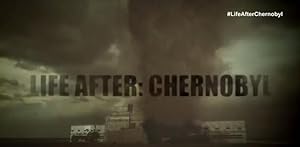I put Life After: Chernobyl in my queue because of the title. It sounded like it was related to Life after People, a series that I loved, and I’m curious about Chernobyl (no, I haven’t seen the HBO miniseries yet, but I would like to). I was unaware until after I watched the forty-three minute show that it was part of a TV series called Animal Planet Presents, which only lasted one season, and was episode 19. Given the length of the show, it wasn’t a surprise.
Life After: Chernobyl is more interested in drama with the veneer of science, and even though I love that kind of entertainment, it was a little transparent when the hosts, i.e. scientists, Mary Ann Ochota, an anthropologist, and Rob Nelson, a biologist, kept adding radiation, mutant or dangerous as an adjective to anything. At one point, Ochota says, “So much science needs to be done here.” It is unintentionally hilarious. There is a deep voiced narrator who jazzes things up. There is so much filler that the hosts talk about what is going to happen, we see it happen then they explain what we saw. We watch them go through military training that seemed less exciting than your friendly neighborhood militia illegally occupying federally (not) protected land for Native Americans. They list their protective equipment, which sounded as if the average painter could pick it up at your local home depot. Scientific equipment shown on screen is barely held together with duct tape, which is probably the most realistic part of the “documentary.”
Side note: to be fair, I don’t know much about anthropology, and I’m not trying to crap on it as an academic field regardless of how many times that I saw Midsommar, but considering that the majority of Life After: Chernobyl focuses on animal life, not people, why do we need an anthropologist? When I was younger, it would never occur to me to even ask that question because I would just be hypnotized by the British voice into automatically thinking that she is qualified and psyched to see an ethnically mixed woman (part Indian and Polish) on my TV screen. To be fair, she is probably the unofficial interpreter onscreen because she speaks the language, but I don’t get it. Please bear in mind that I’m not trying to promote Rob considering that he uses biology to make off-colored jokes on a program that is probably more geared towards kids so the parents could get a chuckle.
Other guest scientists who allegedly actually work on the land have their moment in the spotlight, but I suspect that because they are locals, they maybe can’t speak a lot of English so it sounds like they were fed their lines or only gave one-word answers while the hosts dominate the screen time. The exception was another American scientist, Tim Mosseau, who is actually associated with a university unlike the hosts, who may also share that qualification, but Life After: Chernobyl did not highlight it in the introduction.
Life After: Chernobyl starts with doom and gloom then tries to end on a high note. Good news: if you add something to your diet, you can protect yourself from radiation! What is the secret ingredient? They never say. Yes, you sat through endangered horses being put in more danger, aggressive “radioactive wolves” (wolf to be fair), a killer boar who really did nothing but eat nuts while Ochota tried to make it seem as if he would snap any minute, dead trees, dry leaves, “great tits” and mutant catfish to NOT find out exactly what is keeping the voles healthy. I want my $1.99 back Amazon Prime! (Disclaimer: I saw it on Hulu as part of my subscription, but remembered nothing from the first round so when it was time to write the review around five months later so I figured watch it again.)
The coolest part of Life After: Chernobyl was a section devoted to spiders that reminded me of Season 1 of Hannibal when a person’s mental capacity was measured by how he drew a clock. Apparently their webs are a mess. If this segment was junk science, they got me so well done.
The most dangerous part of Life After: Chernobyl was in their effort to build up more breathless terror, they theorized how a forest fire could create a larger amount of fallout of radiation. It is cool to note that because most of the organisms that aid in the decomposition process are dead, the trees and leaves are frozen in time, but really emphasizing how dry it is seems like the anti-Smokey the Bear thing to do.
The most anti-climactic part of Life After: Chernobyl was when Ochota said that she felt like a spy for arranging a clandestine meeting that would be aired on television without disguising the interviewees’ faces. Who are these interviewees? A sad old couple. They had a cute sleeping cat and lots of farm animals-just a normal radioactive pig, not “the face of a killer” boar.
Life After: Chernobyl is entertaining, but ultimately forgettable and a bit of a joke, but a funny one so I wouldn’t dive for the remote if it suddenly came on. It is definitely not must see television, but it is amusing enough for some solid family time spent in front the screen though you may want to chase it with an actual scientific fact check.
Stay In The Know
Join my mailing list to get updates about recent reviews, upcoming speaking engagements, and film news.





